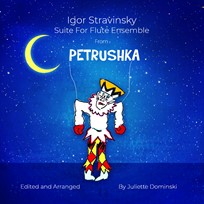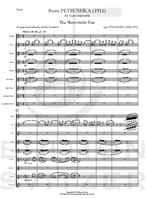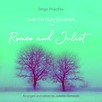
Petrushka
Composer: Igor Stravinsky
Instrument: Flute Ensemble
Level: Advanced
Published: 2018
Price: €38.00
Item details
-
Description +
-
Duration: 12 min.
Colourful ribbons flying in the air, a cheerful crowd, a traditional fair taking place on the village square...These are the pictures that first come to my mind when I think of Petrushka. However, despite the joyful atmosphere, the main character's fate remains terribly sad.
Petrushka, a straw and fabric puppet, has been magically brought to life and thus endowed with real feelings by the Charlatan, his owner.
Yet he remains figuratively a puppet, manipulated by the Charlatan who constantly plays with him and controls his emotions : Petrushka will be rejected by the puppet he's in love with, the Ballerina, he will become jaelous of the Moor, and will finally be killed by his rival.
I've always been fascinated by Stravinsky's masterpiece. Firstly because the storyline, seemingly light and cheerful, deeply questions the human condition. And Stravinsky’s music, with such a complex structure yet inspired by popular songs, with the depth of sound and orchestration colors it provides to the orchestra, perfectly fits this philosophical tale.
The Sub-Bass Flute (Double Contra-Alto or Sub-Contrabass)it’s in G and sounds one octave lower the regular Alto Flute.
The Contrabass Flute (Double Contrabass)
The range is similar to the regular flute, except that it’s pitched two octaves lower. These two instruments are mostly used in the largest of flute choirs.
-
-
Instrumentation +
-
Flute Ensemble:
Piccolo
4 Flutes
Alto
Bass Flute
Sub Bass Flute
Contra Bass Flute
-
-
About the composer +
-
Igor Fyodorovich Stravinsky (17 June [O.S. 5 June] 1882 – 6 April 1971) was a Russian (and later, a naturalized French and American) composer, pianist and conductor. He is widely considered one of the most important and influential composers of the 20th century.
Stravinsky's compositional career was notable for its stylistic diversity. He first achieved international fame with three ballets commissioned by the impresario Sergei Diaghilev and first performed in Paris by Diaghilev's Ballets Russes: The Firebird (1910), Petrushka (1911) and The Rite of Spring (1913). The last of these transformed the way in which subsequent composers thought about rhythmic structure and was largely responsible for Stravinsky's enduring reputation as a musical revolutionary who pushed the boundaries of musical design. His "Russian phase" which continued with works such as Renard, The Soldier's Tale and Les Noces, was followed in the 1920s by a period in which he turned to neoclassical music. The works from this period tended to make use of traditional musical forms (concerto grosso, fugue and symphony), drawing on earlier styles, especially from the 18th century. In the 1950s, Stravinsky adopted serial procedures. His compositions of this period shared traits with examples of his earlier output: rhythmic energy, the construction of extended melodic ideas out of a few two- or three-note cells and clarity of form, and of instrumentation.
-
-
Credits +
-
Front Cover graphics and layout: Gaia Rodriques
Drawing: Tomas Brundin
Engraving: Ary Golomb
Printed in Copenhagen, Denmark
Copyright © Edition SVITZER
www.editionsvitzer.com
-


